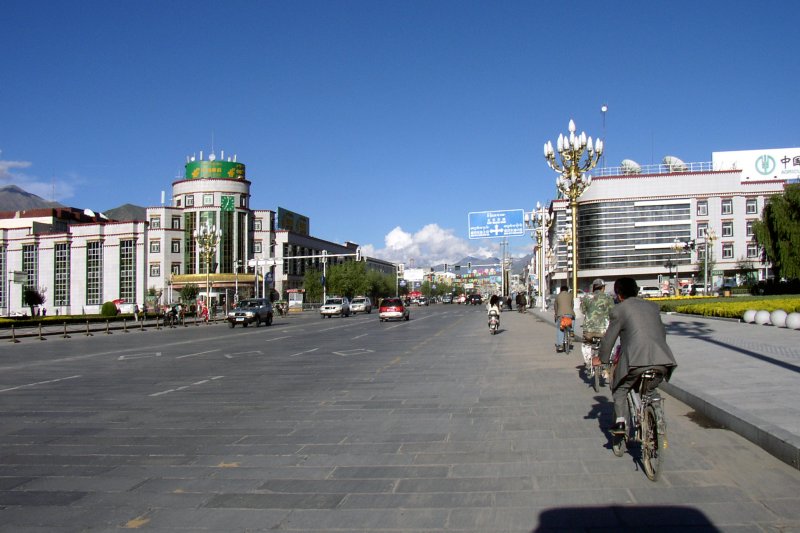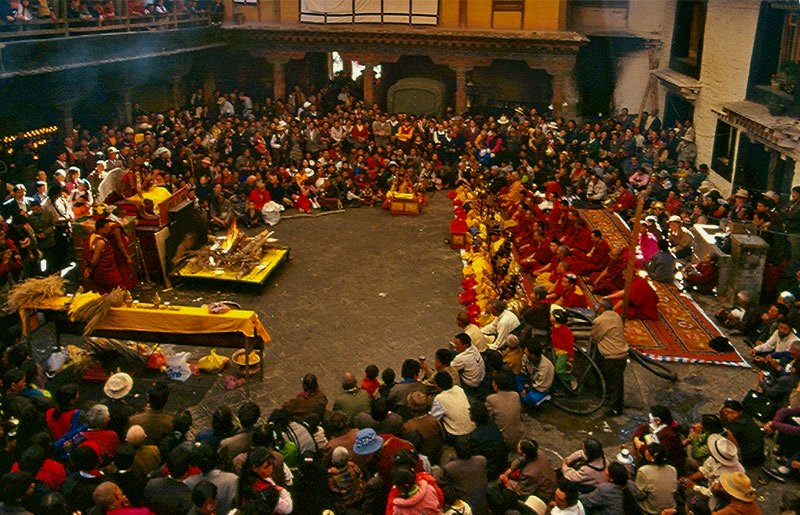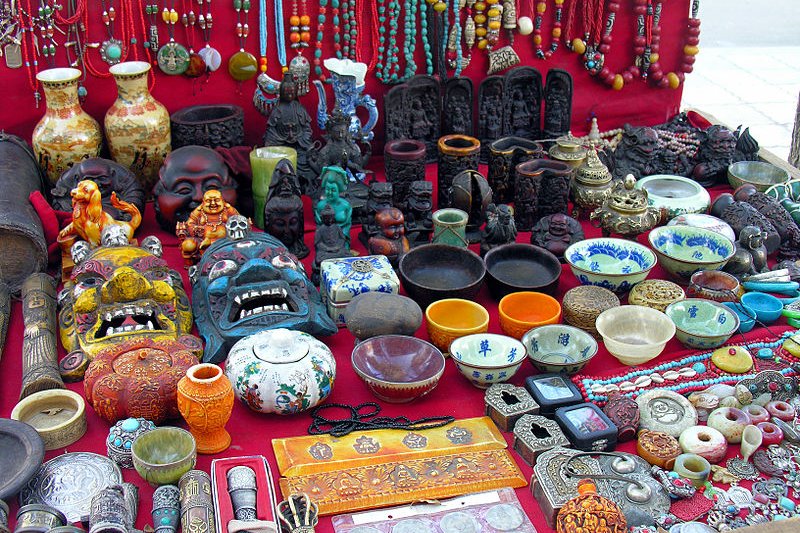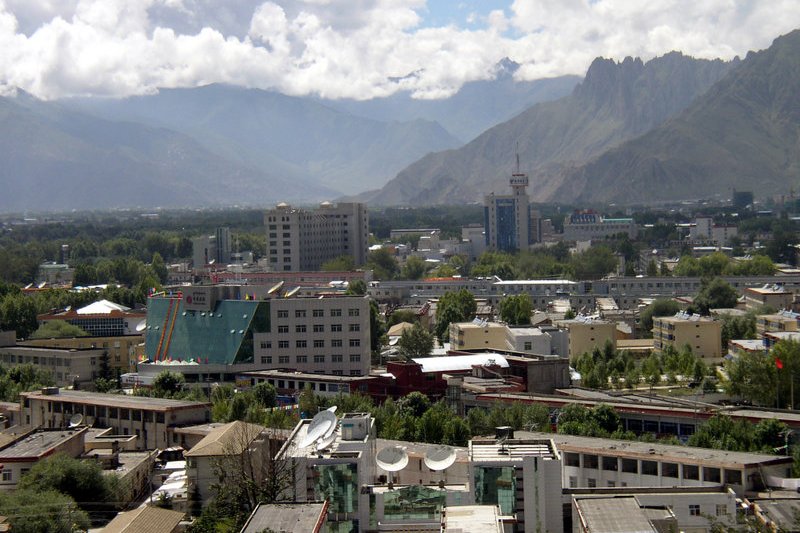

Lhasa
 Go Back - Latest PENANG Sights/Streets/New Properties > Malaysia > World | Hokkien : Lessons : Dictionary | YouTube | Facebook | About Me : Contact Me
Go Back - Latest PENANG Sights/Streets/New Properties > Malaysia > World | Hokkien : Lessons : Dictionary | YouTube | Facebook | About Me : Contact Me Lhasa, China
Lhasa, ChinaSource: https://commons.wikimedia.org/wiki/File:Lhasa_from_Potala_place.JPG
Author: Rainer Haessner

Lhasa is the biggest city as well as administrative capital of the Tibet Autonomous Region in China. It is located at the foot of Mount Gephel. Standing at an elevation of 3,490 meters (11,450 feet), Lhasa is one of the highest capitals in the world.
Lhasa is the home of the Potala Palace and Norbulingka, both World Heritage Sites.
Lhasa was founded in AD 637 when Songtsän Gampo, founder of the Tibetan Empire, moved his capital there. Construction of the first buildings of the Potala Palace began soon after, making Lhasa both the political as well as religious center of the Tibetan people. The empire survived until the 9th century, when it collapsed and its sacred sites destroyed.
 Inside Jokhang Temple, Lhasa
Inside Jokhang Temple, LhasaSource: https://commons.wikimedia.org/wiki/File:Jokhang_C.jpg
Author: Baldiri

It started to regain its glory with the construction of three large Gelugpa monasteries by the famous Tibetan Buddhist teacher Je Tsongkhapa. In 1642 the 5th Dalai Lama, Lobsang Gyatso conquered Tibet and made Lhasa his administrative capital. Construction of a new Potala Palace began in 1645.
At the beginning of the 20th century, Lhasa was a major center of Tibetan Buddhism, with nearly half its population comprising Buddhist monks. The invasion of Tibet by the People's Liberation Army in 1950 caused a mass exodus of Tibetans. It also compelled the 14th Dalai Lama to flee into exile on 1959.
The People's Liberation Army's entry into Tibet was regarded as a peaceful liberation in accordance to the Seventeen Point Agreement signed between delegates of the Dalai Lama and the government of People's Republic of China on 23 May 1951 in Beijing. The validity of the Seventeen Point Agreement has long been disputed by the Dalai Lama, claiming that the signing was done under duress. China regarded it as legally binding, pointing out that the Tibetan delegates signing the agreement were not subject to any physical harm.
 Lhasa street market
Lhasa street marketSource: https://commons.wikimedia.org/wiki/File:Items_for_sale_on_street_of_Lhasa_-_Flickr_-_archer10_(Dennis).jpg
Author: Dennis Jarvis

The objection to Chinese presence in Tibet has resulted in several major demonstrations in Lhasa, making it one of the most volatile cities in China. Due to this, non-Chinese nationals wishing to visit Tibet has to obtain a special permit. Group permits for 5 persons or more are much easier to obtain than individual permits.
Planning your trip to Lhasa
By PlaneYou can fly into Lhasa from Beijing, Chengdu, Chongqing, Guangzhou, Kunming and Shanghai, among others. Remember to get your permit before arriving.
By Bus
There are buses to Lhasa from Golmud in Qinghai province, but it is really not worth trying to reach Lhasa by bus as the issue with the permit makes the journey as expensive as flying in.
 Lhasa, as seen from the Potala Palace
Lhasa, as seen from the Potala PalaceSource: https://commons.wikimedia.org/wiki/File:Lhasa_from_Potala.JPG
Author: Rainer Haessner

Exploring Lhasa
It is quite possible to explore Lhasa on foot. For longer distances, there are cycle rickshaws. Bargain down to a reasonable price.Places of Interest in Lhasa
- Potala Palace
This monumental palace is the biggest structure in Lhasa. Built on its highest mount, it looms over the town. World Heritage Site since 1994. - Jokhang Temple
The most sacred temple in Tibetan Buddhism. World Heritage Site since 2000. - Norbulingka Summer Palace
Constructed by the 7th Dalai Lama in 1755 and subsequently renovated by successive rulers. World Heritage Site since 2001. - Drepung Monastery
Biggest and richest monastery in Tibet, this monastery was founded by Jamyang Choje, disciple of Tsongkhapa, founder of tye Yellow Hat order of Tibetan monks. - Sera Monastery
Monastery famous for its tantric teachings. - Tibet Museum
Museum showcasing the history and culture of Tibet, with a "very Chinese perspective" on the "peaceful liberation" of Tibet. - Barkhor Street Market
Old bazaar street around the Jokhang Temple. - Lukhang Temple
Temple on an island in a lake behind the Potala Palace. - Ramoche Temple
Sistem temple to Jokhang Temple, this 3-storey temple is located north of the Bakhor area. - Ani Tsankhung Nunnery
Located in one of the busy back alleys south of the Barkhor area is this nunnery in a yellow building. - Nechung Monastery
Located southeast of Drepung Monastery, this is the seat of the Tibetan Oracle. The last oracle fled to India in 1959, and today the monastery is only occupied by caretaker monks. - Ganden Monastery
The farthest monastery from Lhasa, this monastery is worth visiting for its scenic setting on the Gokpori Ridge.
Farther Away Sights
- Samye Monastery
150 km southeast of Lhasa, this is a stunningly beautiful monastery in a scenic location. - Tsurphu Monastery
70 km west of Lhasa. Founded in the 12th century by the Black Hat order of Tibetan monks. - Namtso Lake
200 km northwest of Lhasa. Scenic Tibetan lake with azure water beneath snowcapped peaks. - Gyantse
Tibet's third largest settlement is a small, dusty, rustic town, 255 km southwest of Lhasa.
 Latest updates on Penang Travel Tips
Latest updates on Penang Travel Tips
 Discover with Timothy YouTube Channel
Discover with Timothy YouTube Channel
 PG Food Channel
PG Food Channel
 Learn Penang Hokkien YouTube Channel
Learn Penang Hokkien YouTube Channel
 SojiMart Videos
SojiMart Videos
 Share your travels and/or ask a travel-related question
Share your travels and/or ask a travel-related question
Join the Penang Travel Tips Facebook Group to share photos, tips and anything related to your travels, or ask travel-related questions.
 Map of Roads in Penang
Map of Roads in Penang
Looking for information on Penang? Use this Map of Roads in Penang to zoom in on information about Penang, brought to you road by road. Discover with Timothy
Discover with Timothy
Let me take you to explore and discover Penang through my series of walking tours on YouTube. You may use these videos as your virtual tour guide. At the beginning of each video, I provide the starting point coordinates which you may key into your GPS, Google Maps or Waze, to be navigated to where I start the walk, and use the video as your virtual tour guide.Disclaimer
Please use the information on this page as guidance only. The author endeavours to update the information on this page from time to time, but regrets any inaccuracies if there be any.Latest from Discover with Timothy: Gurney Bay - what to see and do there
About this website

Hello and thanks for reading this page. My name is Timothy and my hobby is in describing places so that I can share the information with the general public. My website has become the go to site for a lot of people including students, teachers, journalists, etc. whenever they seek information on places, particularly those in Malaysia and Singapore. I have been doing this since 5 January 2003, for over twenty years already. You can read about me at Discover Timothy. By now I have compiled information on thousands of places, mostly in Peninsular Malaysia and Singapore, and I continue to add more almost every day. My goal is to describe every street in every town in Malaysia and Singapore.
Robbie's Roadmap
- Episode 1: Robbie's Journey to Financial Freedom
- Episode 2: Lost in America
- Episode 3: The Value of Money
- Episode 4: The Mentor
- Episode 5: The Thing that Makes Money
- Episode 6: The walk with a Billionaire
- Episode 7: The Financial Freedom Awakening
- Episode 8: Meet Mr Washington
- Episode 9: The Pizzeria Incident
Copyright © 2003-2024 Timothy Tye. All Rights Reserved.